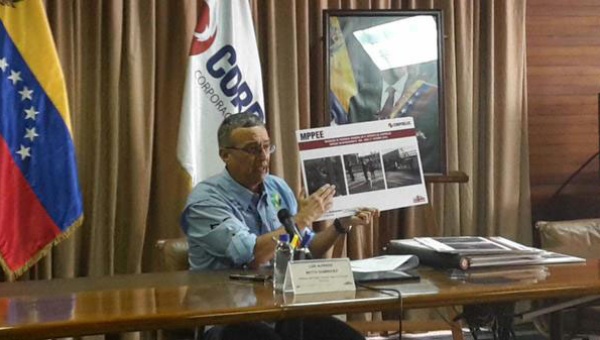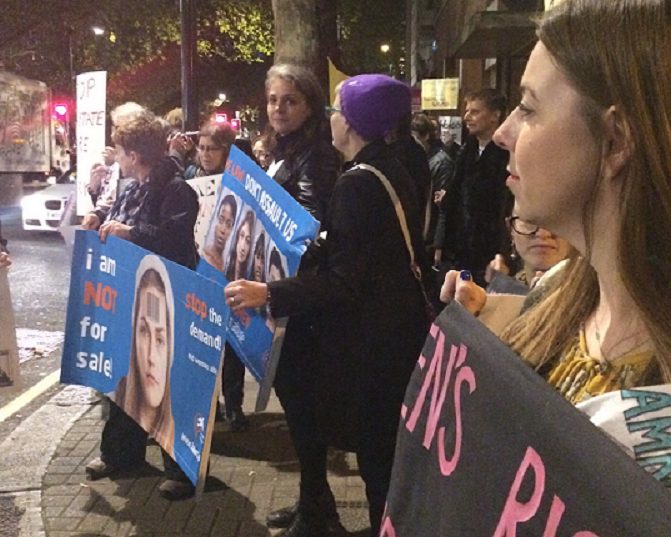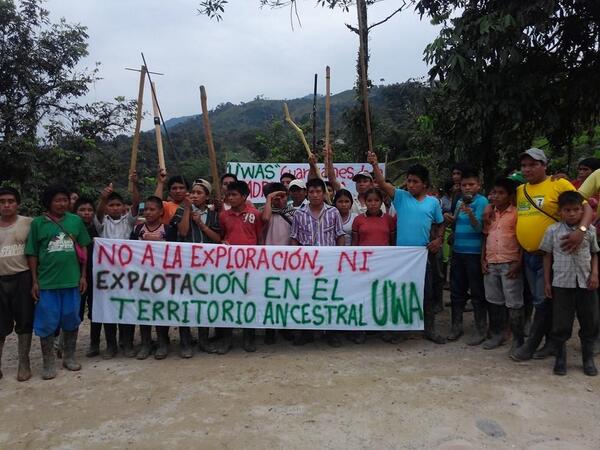
by DGR Colorado Plateau | Nov 5, 2015 | Property & Material Destruction
By Telesur
Venezuelan Energy Minister Luis Motta Domínguez reported that more than a dozen attacks had taken place in less than a week.
Venezuelan Electrical Energy Minister Luis Motta Dominguez reported that 13 attacks on Venezuela’s electrical grid took place over the last week, in an attempt to destabilize the Dec. 6 National Assembly elections.
Motta Dominguez presented the information at a press conference on Monday.
“The electrical system in the 18 days of October has received 13 attacks, 13 acts of sabotage, which also destabilizes the system,” he said. “They are intended to disturb and disrupt the elections on December 6.”
Dominguez said that “in previous elections, there were power outages just two days before the elections, and they are repeating the pattern.”

The minister of electrical energy reported the intrusion of armed people in the Corpoelec depot. | Photo: @MPPEE
According to Motta Dominguez the sabotage began on October 13 at a power plant in Zulia state, located in the northwestern corner of the country, where they cut part of the wiring. The owner showed pictures explaining a failure in the Guyana A line.
“The next attack was in Falcon (located in the northwest of the country), where a citizen was found manipulating a power transformer,” Motta Dominguez said. He also reported three attempts to hack the official website of Corpoelec, the state corporation responsible for Venezuelan power.
The minister reported an explosion and fire in a power transformer in Tachira – located in the Andes mountains, to the southwest of the country – which has affected two electrical substations. It was determined that the damage was caused by two bullet holes, leaving the people of Tachira without 200 megawatts of energy.
“Note that all the attacks are concentrated in Falcon, Zulia and Tachira, all border states,” he concluded. “It is no accident.”
Read more at: Massive Electrical Sabotage Reported in Venezuela
by DGR Colorado Plateau | Oct 30, 2015 | Indigenous Autonomy, Obstruction & Occupation
By SAVE Rivers, JOAS, The Borneo Project, BMF and BRIMAS / Intercontinental Cry
Indigenous resistance against the proposed Baram Dam receives international support for the celebration of the second year anniversary of the Baram Dam blockades: indigenous anti-dam activists from many parts of the world adopt declaration at the banks of the Baram River in Sarawak, Malaysia.
(BARAM / SARAWAK / MALAYSIA) On October 23rd 2015, indigenous communities from around the world gathered on the banks of the Baram River in Sarawak, Malaysia in the context of the second year anniversary of the indigenous-led blockades against the proposed Baram Dam. Two years ago indigenous communities set up two blockades and chased workers and researchers from the site. The works on the dam have come to a standstill and last month the government of Sarawak announced a moratorium.
Indigenous anti-dam activists from Indonesia, the Philippines, Cambodia, Brazil, the US, Honduras, and from around Malaysia united at the blockades to stand in solidarity with the resistance against the Baram Dam and to strengthen ties between their communities. The week-long event is called the World Indigenous Summit on Environment and Rivers, WISER Baram 2015, and was hosted by the grassroots network SAVE Rivers.

During celebrations at the two blockades, the proposed dam site, as well as at a conference in the town of Miri, the participants were united by the similarities between their struggles. “I have gained a lot of experience from all of the delegates. And with such information, I am confident enough such experiences will be fundamental to us – the Baram People – and our strategies to continue to fight and stop the proposed Baram Dam,” said James Nyurang, who hosted the delegates at his village.
According to Berta Cáceres, 2015 Goldman Prize winner from Honduras, “this summit on indigenous peoples and rivers has a special value in that its actions give strength to the historic resistance of our peoples and makes visible the grave aggressions and conflict generated by the privatization of rivers and the construction of dams within Indigenous communities and regions.”

The declaration also calls on governments and institutions to stop presenting dams as climate neutral, and recognize that dams emit large amounts of greenhouse gases, including methane.
Participants in the summit collectively produced a declaration that acknowledges the widespread suffering and destruction caused by dams, and stresses the importance of obtaining Free, Prior, and Informed Consent from communities impacted by dam building. It urges all stakeholders to act in full accountability, transparency, and compliance of all human rights principals and values.
The indigenous defense of the Baram river stands united with other communities’ struggles for land, livelihood, spirituality, identity, and community cohesion.

by DGR Colorado Plateau | Oct 25, 2015 | Prostitution, Protests & Symbolic Acts, Women & Radical Feminism
By Janie Davies / Feminist Current
Women protested in 50 countries on October 23, united in their opposition to Amnesty International’s recommendation for full decriminalization of the sex industry, including pimps and johns.
The campaign was organized by a coalition of individual women and women’s groups, collectively referred to as Amnesty Action.
All these women know that where full decriminalization or legalization of the sex trade take place, trafficking rises. This stands to reason because as scrutiny is removed, organized criminals are able to operate more freely.
They know that an estimated 89 per cent of women in prostitution want to get out; that about half have been raped, approximately 70 per cent have been assaulted, and that the average age of entry is 13-15 years old.
In London, police estimated the number of women outside Amnesty International’s headquarters at 200. There were exited women there, with activists, researchers, journalists — all in sisterhood. The youngest were in their twenties, the oldest were in their eighties.
They were later joined by a few men, one of whom said he’d heard about the protest in an Italian Facebook group two hours before and apologized for not having got involved sooner.
The protesters stood alongside the busy road in London’s rush hour and chanted: “Lock up pimps and johns!” “Women’s rights are human rights!” “Women’s bodies are not for sale!” One brought a mobile speaker and played “All Night Wrong,” a protest song written by Jeanette Westbrook.
They stayed for an hour and a half, refusing to move when asked, reminding Amnesty International staff that the pavement they were standing on was private property.
A particularly enthusiastic security guard was told off more than once for ordering the women around and pointing his finger at them.
His attempt at directing proceedings was feeble and failed miserably.
London’s red double-decker buses stopped in traffic, with passengers watching with interest. Drivers opened their windows to receive cards handed out by the protesters. Passers by gave their details, intending to get involved with the wider campaign.

The was one minor altercation with a passing man who objected to having his path obstructed.
The Amnesty Action women were in an unexpected position; having to oppose the world’s leading human rights organization in the name of women’s and girls’ rights. Women and girls are human, after all…
It speaks volumes that since Amnesty International agreed to the policy in August. A large number of women’s rights organizations have came out in opposition of the decision and in support of the Nordic model, which decriminalizes only the sale of sex and promotes exit plans to get women out of prostitution.
Amnesty International’s policy lets women and girls down, putting their rights last as it declares that access to sex is a human right.
Actually, the right not to suffer inhuman or degrading treatment is guaranteed by Article 3 of the European Convention on Human Rights and the Universal Declaration of Human Rights. This is also guaranteed under both the Palermo Protocol (the UN Trafficking Protocol) and theConvention for the Elimination of All Forms of Discrimination Against Women (CEDAW), as well as the 1949 Convention, which recognize prostitution as exploitation.
The absurdity of the situation was summed up by Lisa-Marie Taylor, chair of UK women’s rights charity Feminism in London.
“We cannot and will not stand by whilst a human rights organization supports, encourages, and lobbies for the prostitution of women and by extension girls. This flies in the face of the available evidence and we call for human rights organisations to review their position in the light of emerging data from areas that have implemented the model of legalization with appalling consequences,” Taylor told Feminist Current.
The global Amnesty Action protest took place a day before Feminism in London’s annual conference, so a lot of women’s rights activists were already in town
Among them were Canadian registered nurses Linda MacDonald and Jeanne Sarson, the world’s leading authorities on Non-State Torture.
The two founders of Persons Against Non-State Torture know that trafficked and prostituted women are extremely vulnerable to acts of torture committed in the private sphere.
“I am here to share the voices of women who talk about the grave suffering they have endured in their ordeals in Non-State Torture, including the torture that happens in prostitution. I want to shout to the roof tops and to Amnesty International that torture is not work,” Linda MacDonald told Feminist Current.
The two women have spent 22 years supporting victims and campaigning for Non-State Torture to be classified as a specific human rights crime.
“We will never shut up about Non-State Torture,” Jeanne Sarson told Feminist Current.
Feminist Current also caught up with feminist writer and activist, Anna Djinn.
“We are already seeing the Amnesty resolution being used to justify decriminalization of the sex trade and men buying sex, even though everywhere that has implemented full decriminalization has seen an upsurge in sex trafficking. [In Germany], 55 women have been murdered by pimps and punters in the 13 years that the country has had full decriminalization. Only one woman has been murdered in Sweden during its 16 years of the Nordic Model. Amnesty’s policy is steeped in the mindset of male supremacy and has failed to realize that women and girls are human beings with inalienable rights to live in dignity. We are here to remind Amnesty that they are wrong and must redress this terrible mistake,” Djinn toldFeminist Current.
If pimps and johns cannot be arrested and prosecuted for simply participated in an abusive supply chain, authorities must wait for them to actually harm women in the sex trade before they can act.
This is why Amnesty Action will not stop until Amnesty International sees sense and commits to respecting the human rights of women and girls, worldwide.
Janie Davies is a British journalist and feminist living in South West London. She volunteers with women’s rights groups and supports those campaigning for the implementation of the Nordic model. Follow Janie Davies on Twitter @Janie_R_D.
by DGR Editor | Oct 19, 2015 | Strategy & Analysis, The Problem: Civilization
by Kim Hill / Deep Green Resistance Australia
A sustainable population ensures that the population of all other species who share the land where they live is also sustained. A population that causes the extinction of another species is not sustainable. Earth’s current human population causes the extinction of 200 species per day.
A sustainable population can endure indefinitely. This is the definition of sustainability. The number of people that can truthfully be called “a sustainable population” is not something that can be decided by popular vote, by argument, by economics, or by force. It is decided by the carrying capacity of the land on which it lives.
Ninety per cent of large fish in the ocean are gone. Ninety nine per cent of old growth forests, gone. That’s ninety nine per cent of the habitat that can sustain a human population. This means that as of now, a sustainable population of humans on this planet is one per cent of the population that a pre-industrial planet has sustained.
The civilization that most humans currently live in is not a sustainable habitat, as it requires stealing from the surrounding land to maintain itself. And as the civilized area grows to take over everything, and the land left available to steal from therefore shrinks to nothing, the whole project inevitably dies.
And the maximum possible population for any piece of land is not desirable for that population, as there is no chance for that population to survive in the face of disaster, environmental change, flood, or drought. An optimal population allows for some redundancies in providing for its needs. A population below carrying capacity will also be more peaceful, as it has everything it needs, and some to spare for others travelling or migrating. An optimal population doesn’t need to be constantly on guard to defend its landbase. Although this is conditional on the populations of surrounding areas also being optimal for their own landbases, rather than expanding and colonising.
A population’s ability to sustain itself isn’t a function of the number of people, but the relationship between the people and the land they live on. If the people exploit the land, taking more from it than they give in return, then regardless of the number of people, they will soon reach a point where the land no longer sustains them, and they either move on or starve to death. And in the present world, moving on means forcefully invading the land of others. Causing them to starve to death.
A population that has reciprocal relationships with the land, plants and animals that provide for their needs, and takes responsibility for the wellbeing of these others, may not even need to consider the question of population, or population may be regulated by an intuitive understanding of these relationships.
In the current context of global population overshoot, any strategy that addresses population as an isolated issue is bound to fail. Putting the cart before the horse.
It isn’t possible for a government that exists within the paradigm of economic growth to effectively address the issue of population.
Economic growth leads population growth. More people buy more stuff. Even if economic growth is possible without population growth, the economy still undermines its own foundations (quite literally in the case of mining taking over agricultural land) and will lead to whole populations of humans collapsing, regardless of the number of people.
So to see population as an issue that needs addressing is to miss the point.
Sustainability is not an abstract concept, or an optional extra for rich people to feel good about. Sustainability is by definition the capacity to continue to exist. If something is not sustainable, it will soon cease to exist. Any policy or argument that claims sustainability as a virtue without understanding this core meaning will benefit no-one, and only lead to a more chaotic collapse.
Often at policy discussions, someone will mention population and use the phrase “the elephant in the room” as if they’ve said something terribly clever and important, and done their bit to address the issue. I’ve never heard a proposal for any real action to either reduce global population or stop it from growing. Here’s some policy options: mass murder, forced sterilisation, a deadly virus, one-child policy, withhold food so that people starve. I can’t imagine anyone wanting to be on the receiving end of any of these, although there may be willingness to accept a one-child policy.
Stopping population growth is not in the interest of any government, especially not one elected on four-year term. Governments want as many people as possible – to grow their economy, fight their wars, work their industries, buy products, pay taxes.
Attempts to influence governments to instate policies on population are unlikely to be effective. Governments need to act in the interests of their corporate investors (or employers, or shareholders, depending on how you look at it). To influence a government requires influencing the corporations that control it.
A corporation has profit-making as its core business. No matter how convincing an argument may be, a corporation won’t act on it if its not profitable. And reducing population, the market for their products, can never be profitable.
Corporations can’t be challenged by legal means, as they have power over the legal system. So anyone wanting to challenge a corporation can only do so illegally.
By thinking strategically, and having the goal of preventing a corporation from doing business, its not all that hard to bring it down.
A corporation is a vulnerable thing. It can’t work without electricity, internet, phone connections, transport systems, workers, and money. If the supply of any one of these things is cut off, business stops.
By refusing to acknowledge the underlying causes of population growth, the debate on population is feeding and breeding the metaphorical elephants it so loves to talk about.
What I see is an overpopulation of elephants in the room.
Editor’s Note: Originally published March 7, 2013 on Stories of Creative Ecology








